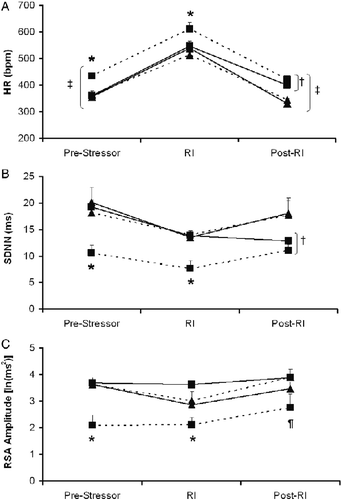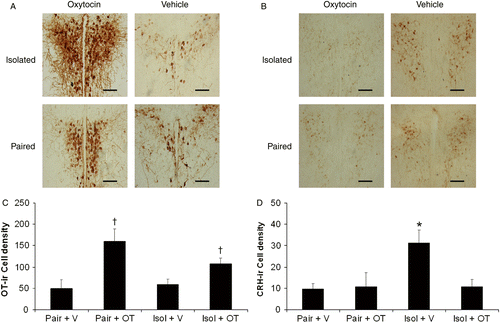Figures & data
Table I. Timeline of procedures in this study.
Table II. Behavioral responses in the open and closed arms of the 5-min EPM test in prairie voles following 4 weeks of social isolation or pairing plus daily exogenous administration of either oxytocin (20 μg/50 μl/vole, sc) or sterile saline vehicle (50 μl/vole, sc).
Figure 1. Mean ( + SEM) HR (Panel A), SDNN Index (Panel B), and amplitude of RSA (Panel C) before, during, and following the 5-min EPM test in prairie voles following 4 weeks of social isolation or pairing plus daily exogenous administration of either oxytocin (20 μg/50 μl/vole, sc) or sterile saline vehicle (50 μl/vole, sc), in the following groups: Paired+V (‐‐▴‐‐; n = 6), Paired+OT (—▴—; n = 5), Isolated+V (‐‐▪‐‐; n = 6), and Isolated+OT (—▪—; n = 5). Three-factor mixed-design ANOVA with post-hoc multiple comparisons: *P < 0.05 versus Paired+V, Paired+OT, and Isolated+OT groups at the same time point; †P < 0.05 versus two paired groups at the same time point; ‡P < 0.05 versus respective EPM value. Abbreviations: ANOVA, analyses of variance; EPM, elevated plus maze; HR, heart rate; OT, oxytocin; RSA, respiratory sinus arrhythmia; SDNN, SD of normal-to-normal intervals; SEM, standard error of the mean; V, vehicle.

Table III. Behavioral responses in the 5-min RI paradigm in prairie voles following 4 weeks of social isolation or pairing plus daily exogenous administration of either oxytocin (20 μg/50 μl/vole, sc) or sterile saline vehicle (50 μl/vole, sc).
Figure 2. Mean ( + SEM) HR (Panel A), SDNN Index (Panel B), and amplitude of RSA (Panel C) before, during, and following the 5-min resident–intruder paradigm in prairie voles following 4 weeks of social isolation or pairing plus daily exogenous administration of either oxytocin (20 μg/50 μl/vole, sc) or sterile saline vehicle (50 μl/vole, sc), in the following groups: Paired+V (‐‐▴‐‐; n = 6), Paired+OT (—▴—; n = 5), Isolated+V (‐‐▪‐‐; n = 7), and Isolated+OT (—▪—; n = 5). Three-factor mixed-design ANOVA with post-hoc multiple comparisons: *P < 0.05 versus Paired+V, Paired+OT, and Isolated+OT groups at the same time point; †P < 0.05 versus two paired groups at the same time point; ¶P < 0.05 versus Paired+V and Isolated+OT groups at the same time point; ‡P < 0.05 versus respective RI test value. Abbreviations: ANOVA, analyses of variance; HR, heart rate; OT, oxytocin; RI test, resident–intruder paradigm; RSA, respiratory sinus arrhythmia; SDNN, SD of normal-to-normal intervals; V, vehicle.

Figure 3. Coronal brain sections (40 μm) from a representative subject in each group showing the density of immunoreactive cell bodies (number of cell bodies per standardized area; oxytocin, Panel A; CRH, Panel B), and mean ( + SEM) group data (oxytocin, Panel C; CRH, Panel D), in the PVN of the hypothalamus of paired and isolated prairie voles following 4 weeks of social isolation or pairing plus daily exogenous administration of either oxytocin (20 μg/50 μl/vole, sc) or sterile saline vehicle (50 μl/vole, sc), in the following groups: Paired+V (n = 7), Paired+OT (n = 6), Isolated+V (n = 7), and Isolated+OT (n = 6). Scale bars = 100 μm. Two-way independent-groups ANOVA with Bonferroni-corrected t-tests for multiple comparisons: *P < 0.05 versus Paired (Pair) + V, Paired+OT, and Isolated (Isol) + OT groups; †P < 0.05 versus two vehicle-treated groups. Abbreviations: ANOVA, analyses of variance; CRH, corticotropin-releasing hormone; ir, immunoreactive; OT, oxytocin; V, vehicle.

